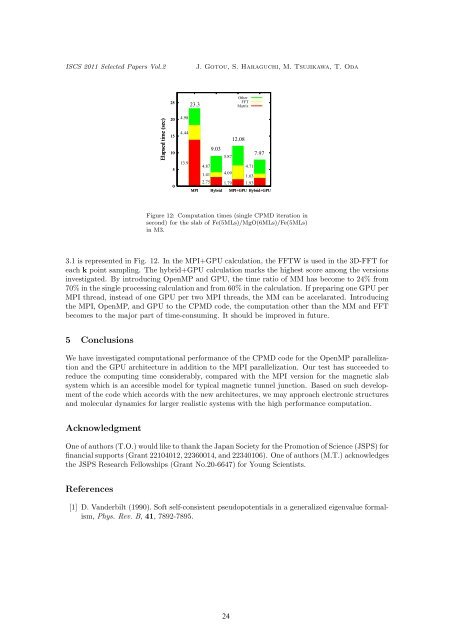RECENT DEVELOPMENT IN COMPUTATIONAL SCIENCE
RECENT DEVELOPMENT IN COMPUTATIONAL SCIENCE
RECENT DEVELOPMENT IN COMPUTATIONAL SCIENCE
You also want an ePaper? Increase the reach of your titles
YUMPU automatically turns print PDFs into web optimized ePapers that Google loves.
ISCS 2011 Selected Papers Vol.2 J. Gotou, S. Haraguchi, M. Tsujikawa, T. Oda<br />
Elapsed time (sec)<br />
25<br />
20<br />
15<br />
10<br />
5<br />
0<br />
4.98<br />
4.44<br />
13.9<br />
23.3<br />
MPI<br />
4.87<br />
1.41<br />
2.75<br />
9.03<br />
Hybrid<br />
5.87<br />
4.09<br />
1.79<br />
Other<br />
FFT<br />
Matrix<br />
12.08<br />
4.71<br />
1.63<br />
1.93<br />
7.97<br />
MPI+GPU Hybrid+GPU<br />
Figure 12: Computation times (single CPMD iteration in<br />
second) for the slab of Fe(5MLs)/MgO(6MLs)/Fe(5MLs)<br />
in M3.<br />
3.1 is represented in Fig. 12. In the MPI+GPU calculation, the FFTW is used in the 3D-FFT for<br />
each k point sampling. The hybrid+GPU calculation marks the highest score among the versions<br />
investigated. By introducing OpenMP and GPU, the time ratio of MM has become to 24% from<br />
70% in the single processing calculation and from 60% in the calculation. If preparing one GPU per<br />
MPI thread, instead of one GPU per two MPI threads, the MM can be accelarated. Introducing<br />
the MPI, OpenMP, and GPU to the CPMD code, the computation other than the MM and FFT<br />
becomes to the major part of time-consuming. It should be improved in future.<br />
5 Conclusions<br />
We have investigated computational performance of the CPMD code for the OpenMP parallelization<br />
and the GPU architecture in addition to the MPI parallelization. Our test has succeeded to<br />
reduce the computing time considerably, compared with the MPI version for the magnetic slab<br />
system which is an accesible model for typical magnetic tunnel junction. Based on such development<br />
of the code which accords with the new architectures, we may approach electronic structures<br />
and molecular dynamics for larger realistic systems with the high performance computation.<br />
Acknowledgment<br />
One of authors (T.O.) would like to thank the Japan Society for the Promotion of Science (JSPS) for<br />
financial supports (Grant 22104012, 22360014, and 22340106). One of authors (M.T.) acknowledges<br />
the JSPS Research Fellowships (Grant No.20-6647) for Young Scientists.<br />
References<br />
[1] D. Vanderbilt (1990). Soft self-consistent pseudopotentials in a generalized eigenvalue formalism,<br />
Phys. Rev. B, 41, 7892-7895.<br />
24


